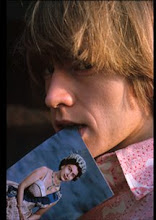

This week in Wonderland we're paying tribute to one of the finest R&B/jazz bands of the era, Manfred Mann. Known primarily in the States for their hit single "Do Wah Diddy Diddy," the Manfreds' repertoire spanned various genres of music from blues to pop. Their story is divided into distinct eras, each with their own unique contributions to the band's history.
Manfred Mann (born Manfred Lubowitz) was born in Johannesburg, South Africa to wealthy parents. At the age of six, he became intrigued by the family piano and expressed a desire to learn to play. He spent up to five hours a day intensely practicing. Manfred's talent led him to study classical music at Johannesburg Witwatersrand University, while simultaneously receiving lessons from American jazz pianist John Mehegan. Manfred despised the racism he witnessed living in Apartheid South Africa, so in 1961, he left home and boarded a boat for England, where he taught music theory and played jazz piano in local London clubs in an attempt to gain permanent residence.
By 1962, Mann had met drummer/vibes player Mike Hugg in Butlins while playing the summer club season, which led to the formation of the Mann-Hugg Blues Brothers. Tom McGuinness soon joined on bass, followed by Mike Vickers on horns and guitar. It wasn't until vocalist Paul Jones joined that the band's singles began to take off. Producer John Burgess insisted on a name change for the group, eventually convincing them that their best choice would be "Manfred Mann," much to the entire band's chagrin (Mann included).
In Feb. of 1964, Manfred Mann released "5-4-3-2-1," (the song in the video above) which became a massive hit in England, and served as the theme song for the pop show "Ready Steady Go!" (This song is sort of their take on "The Charge of the Light Brigade.") Other hit singles followed, including "Hubble Bubble," "Do Wah Diddy Diddy," "Sha La La," and "Come Tomorrow." By 1965, McGuinness was playing lead guitar, and former Graham Bond Organization/future Cream bassist Jack Bruce joined the band for live appearances. Bruce can be heard on their UK number 1 "Pretty Flamingo," which was also Paul Jones' last hit with the group. With the handsome lead singer gone, the band considered several replacements, including Rod Stewart and Wayne Fontana, before choosing Mike D'Abo. Manfred Mann then moved to the Fontana record label where they continued to experience chart success. Bruce left the band in 1967, and was replaced by Beatles friend and
Revolver cover artist, Klaus Voorman.
Some of the Manfreds' best work were their Dylan covers, particularly "With God on Our Side" and the hit "The Mighty Quinn." My personal favorite Manfred Mann album is the 1968 soundtrack to the Paramount film, Up the Junction, with its swirling psychedelic sounds, tape effects, and jazz elements. Their debut, The Five Faces of Manfred Mann, displays the band's deft transition to pop while still retaining their jazz and blues influences - each track is a winner, and it's certainly a classic album.
(References: Mannerisms: The Five Phases of Manfred Mann by Greg Russo and British Beat by Chris May and Tim Phillips)




























